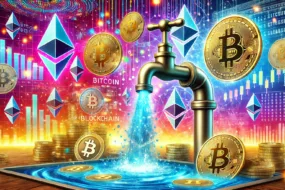
I’m not trying to get philosophical, but we are living two different lives — One in the offline world and the other online. So it’s no surprise to anyone that the time spent online is increasing at a steady pace. In 2022, the global population spends an average of 40% of non-working waking hours online. And it’s expected to reach at least 50% by 2030. Hence, to accommodate this new reality, the internet is evolving into something much bigger called the ‘Metaverse.’ This leads us to the million-dollar question: What is metaverse?
Read on to gain a deeper understanding of this new concept and leverage this new frontier.
What Is the Metaverse?
It all started in 1992 when American writer Neal Stephenson coined the term metaverse in his sci-fi novel ‘Snow Crash.’ Since then, a lot of developments have been made toward creating a real metaverse.
Several games and movies, like Second Life, Pokemon Go, Fortnite, and Ready Player One, show us what the world of the metaverse might look like.
In its current form, Metaverse is a vague term that sounds futuristic and hasn’t fully taken shape yet. Social media and technology companies see it as a fully ‘immersive’ and realistic digital universe that would enable users to access 3-D augmented or virtual environments. It combines the features of online gaming, social media, augmented reality (AR), virtual reality (VR), NFTs, and cryptos to allow users to connect in this online space.
Within this ecosystem, users can interact, socialize, play games, make friends, visit remote locations, work, run businesses, learn new things, etc. It’s like a digital twin — users can exist as a ‘3D avatar’ in this virtual environment and live a life comparable to the real world.
How Does the Metaverse Work?
We don’t have just one social media platform or blockchain for everyone, do we? Similarly, the metaverse isn’t just one digital world that caters to everyone. There will be several digital worlds — some more immersive than others catering to different use cases.
Many companies invest heavily in building their version of the metaverse to satisfy the needs of their audiences.
The digital experience heavily relies on the type of devices being used. Laptops and smartphones allow users to access the most basic form of the metaverse. In contrast, AR devices enhance the physical world, and VR or digital glasses fully absorb the user into the digital realm.
In its current form, it is far from what tech companies envision. This is due to the lack of widespread adoption of VR headsets and digital glasses. Also, the server capacity to accommodate the fully immersive experience is not yet available.
However, most experts agree that the metaverse will become a vast network as technology improves. This growth would create online spaces where user interactions are more multi-dimensional than today.
Eventually, this ecosystem would create a virtual economy using cryptocurrencies and non-fungible tokens (NFT). For instance, a metaverse-based game would allow peer-to-peer interactions to trade in-game NFTs like weapons, skins, land, or tools to enhance the experience. Players can buy or sell these assets using crypto, thus setting up a virtual economy.
What Is Metaverse Avatar?
Metaverse Avatars are our 3D versions in the digital realm. Our physical body defines our existence in the offline world. The same applies to these avatars in the online world.
The exciting part is that avatars can take different humanoid forms or shapes in the metaverse per the user’s wish. On top of that, these avatars have features like moveable limbs, torsos, and a face to deliver non-verbal cues. And of course, they move around the digital world to explore it, just like we explore the physical world.
Examples: How Metaverse is Used Today
Below is a list of companies creating products or services that are shaping the metaverse.
1. Linden Lab
Linden Lab developed an online multiplayer game called ‘Second Life’ in 2003. The game was well known for delivering an early metaverse experience and for introducing the concept of a virtual economy. Users in the game spend money buying assets within the game.
2. Epic Games
Epic Games is the company behind the digital game ‘Fortnite.’ The company is shifting its focus from gaming to creating virtual social experiences (like large-scale concerts or parties).
3. Meta (Formerly Facebook)
Metaverse reached peak popularity when Mark Zuckerberg rebranded Facebook to ‘Meta.’ The platform intends to create social media-based metaverse experiences.
Meta strongly believes that immersive virtual reality experiences are the future of digital social interaction. Hence, it is using Reality Labs (Formerly Oculus), a VR gear company acquired by Meta in May ’14.
4. Microsoft
Microsoft has several projects in motion for building a metaverse:
- Integration of Microsoft Teams into the metaverse for creating an immersive experience for virtual meetings
- Microsoft developed a communication platform called ‘Mesh’ that allows users to collab in a virtual environment using devices like laptops, smartphones, or AR/VR headsets.
5. Roblox
Roblox is an online platform for users to play digital games. The company focuses solely on youngsters, and they are working on creating seamless virtual experiences for gamers.
6. Snapchat
Snapchat has been working on augmented reality. They have introduced AR filters and glass that can enhance the user’s world outside their app.
As you can notice, each company is adapting the business it operates and the technology it has for the metaverse. It ranges from gaming to social media to virtual events and meetings.
Is There Any Difference Between AR and VR?
A big yes! Though both represent 3D content, AR and VR differ in how they express that content.
1. Augmented reality (AR)
Augmented reality combines physical and virtual worlds. This is done by overlaying visual elements, sound, and sensory stimuli onto a real-world environment to enhance the digital experience. PokemonGo is a good example of AR technology.
2. Virtual reality (VR)
VR creates a fully immersive virtual world where users exist in the form of life-size digital avatars. They can interact with other 3D life-size objects with the help of VR headsets. VR-based games have been getting more and more popular in recent times.
Benefits of Metaverse
If you are still with us, let us take some time to review the benefits of adopting the metaverse.
1. Networking
Networking is the most obvious use case of the metaverse. We are social animals, and we crave human connection. Hence, the metaverse aims to enable users to interact with whomever they want across the globe, with virtual meetings using avatars.
2. Education
It’s not far-fetched to imagine metaverse classrooms able to deliver sessions more efficiently than a physical classroom.
3. Employment
Metaverse can lead to the formation of new industries, creating more jobs. New types of jobs within the metaverse ecosystem will emerge. This includes virtual real estate agents and event planners, digital advertising, etc.
4. Gaming
There is a lot of good news for video game lovers. Metaverse shifted the gaming landscape from ‘pay-to-play’ to ‘play-to-earn’ with the help of cryptocurrencies and NFTs. Moreover, users can fully control their in-game assets as blockchain provides immutable proof of ownership.
5. Retail
As more and more people enter the metaverse, global retail brands gain incentive to build their presence within the digital world. Due to consumer demands, a mix of physical and online experiences is becoming the norm. Hence, the metaverse will allow users to interact with brands and their products in a new way.
6. Environmental considerations
Virtual meetings are a great alternative to traveling and can help preserve our environment. However, it misses the much-needed human connection. Metaverse could be the solution to this problem as it can provide an immersive experience that could come close to live interaction. If successful, it would boost sustainability. Not to mention, it’d help our environment by reducing the everyday commute.
Drawbacks of Metaverse
Like any technology, there are downsides to this one as well, which we will discuss to get an accurate picture.
1. Health concerns
Like “Zoom fatigue,” there is another concept called the “VR hangover.” You also have something called “post-VR sadness.” After living in an digital world, users might experience depression and sadness. We can equate this to the current social media platforms. Social media users report experiencing depression due to their social media usage.
2. Addiction
Currently, smartphone or gaming addictions are a problem among kids and adults. Similarly, getting addicted to metaverse platforms could become a problem.
3. Regulations
Tech companies are notorious for acting in the grey areas of the law. Crimes in the virtual space can be really hard to resolve, creating more grey areas. Hence, we will face regulatory issues as technology improves.
4. Identity hacking
Identity hacking is prevalent in the current social media platforms. Twitter has been in the spotlight for several high-profile hacks. In the Metaverse, your avatars could be prone to hacking, creating havoc in your physical and virtual worlds.
5. Privacy issues
Internet users are already bogged down with privacy issues. The existing tracking technology will continue monitoring our behavior in the metaverse too. The only difference is that it will become even more intense and invasive.
How To Invest in the Metaverse
Luckily, there are several ways to invest in the metaverse. Below is a list of potential avenues to invest in this emerging space.
1. Metaverse stocks
People with high risk appetites can indulge in direct stock investments. There are several global giants like Microsoft (MSFT), Meta Platforms (FB), Roblox (RBLX), Nvidia (NVDA), and Qualcomm (QCOM) that are already offering metaverse-related products and services to their customers.
2. Metaverse cryptos
Users have the option to invest in several well-known crypto projects focused on Metaverse-related use cases, primarily online gaming. It includes Axie Infinity (AXS), Decentraland (MANA), Sandbox (SAND), Star Atlas (STAR), Illuvium (ILV), etc.
3. Metaverse Index
Metaverse Index (MVI) is a collection of 15 decentralized tokens created to invest in different metaverse use cases like gaming, entertainment, business, sports, travel, etc. It allows the investors to benefit from investing in the market.
Something similar for you to invest in is the Metaverse Coin Set, so make sure to check that out.
4. Metaverse property or land
Virtual land or real estate could be a great investment. But this is based on the assumption that virtual land is programmed to have a limited supply similar to physical land. Hence, this setup would drive demand in the future as more and more users jump into the metaverse, thus driving up the land value.
If you’re interested in investing in the Metaverse and you’d like more details on that, check out this blog.
How Do I Make Money in the Metaverse?
Investing is a long-term journey and might not be suitable for those who want to make money in a shorter period.
1. Renting metaverse property
Metaverse property owners can rent their virtual land or building to others to set up virtual shops or office spaces or host events and parties.
2. Creating and selling NFTs
NFTs are digital assets like music, art, video, playable characters, and so on that are unique and not interchangeable. People with creativity and designing skills could create NFTs and sell them for a profit within the metaverse.
3. Becoming a real estate agent
Last year accounted for over 500 Million USD in real estate sales in the metaverse. This sales number highlights the need for experienced real estate agents within the virtual world.
4. Engage in play-to-earn (P2E) games
Play-to-earn is a business model where users can play a game and earn cryptocurrency while doing it. It is a powerful concept that combines two critical drivers of human beings — money and entertainment. By participating in the game, players get the chance to earn cryptocurrencies, which they can encash later or use to improve their game performance.
What Are the Metaverse’s Commercial Opportunities?
The metaverse offers several commercial opportunities (mentioned below) for many organizations.
- Connecting with friends
- Digital advertising
- Remote working and collaboration
- Training students or employees
- Enhanced customer engagement
- Virtual concerts
- Immersive entertainment
- Virtual tourism
Companies that can effectively deploy virtual and augmented reality technology will likely perform well and attain higher ROI.
The Future of the Metaverse
Simply put, the metaverse will shift users from just viewing content to living in the virtual world. However, business people, technologists, designers, and users must build the technology together to make it an open, large-scale, and immersive system.
As the metaverse grows, it can disrupt tech and non-tech sectors by changing how people interact.
Conclusion
The metaverse is slowly becoming a reality as it has made its way into our daily lives, from games to real-world applications.
However, it is essential to highlight that we are still in the early stages. Further research is needed to find out its true potential. The space will keep evolving based on consumers and advancement in the relevant technology, leading to more business and employment opportunities.
FAQs
1. How do I make metaverse safe?
The metaverse is bursting with exciting opportunities. At the same time, it’s also muddled with many challenges. So it’s up to all of us to ensure it’s safe.
As a user, one should act responsibly and respect others’ freedom and privacy within the metaverse to keep it safe. On the other hand, companies building metaverse-related products and services need to design algorithms and business models that put safety first. This is especially important in the case of younger users.
2. Can we live in the metaverse?
Yes. We can live in the metaverse in the form of 3D avatars. These avatars can move around the digital world to explore it. You should use VR goggles and other receptive devices to immerse yourself in this virtual environment.
3. How do I buy property in the metaverse?
Several metaverse platforms like Decentraland, Sandbox, and Axie Infinity allow users to buy virtual properties. The users can directly visit these platforms to make purchases.
Please keep in mind that metaverse properties are highly volatile assets. Hence, kindly invest responsibly.




